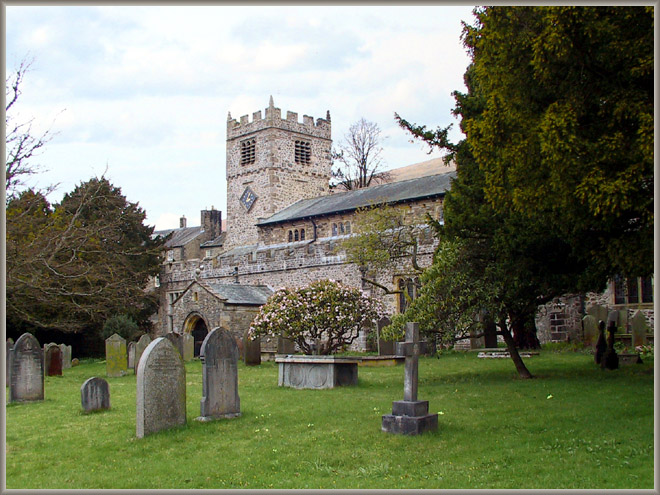

Sedbergh Churchyard, south side
Image © Meg Twycross, 7 April 2003
On 9 June 1652 ('Whitsunwednesday'), after ‘declaring the day of the Lord’ through Sedbergh Hiring Fair, Fox ‘went Into ye steeplehouse yarde ... & there I declared ye euerlastinge truth of ye Lorde & ye worde of liffe for seuerall houres’. Tradition has it that he preached under a yew tree on this side of the church. In his Sedbergh, Garsdale, and Dent, the Rev. William Thompson says that the boys of Sedbergh School in the mid nineteenth century,
... will remember the yew-tree which they used to pass before entering the church. It was the survivor of two hoary sisters which Dr. Whitaker1 notes as moribund in about 1820, and to which he ascribes high antiquity — “two vast yew-trees, now almost in the last period of decay, and in all probability co-eval with the church itself.” The trunk of the survivor had, before the end, become a mere shell, but still supported an umbrageous burden of sombre green. After being shored up for a time, it yielded to the wintry blasts of the night of January 27th, 1877. Popular tradition represents George Fox as having stood beneath it when he harangued the fair folk in the churchyard for several hours. Many articles of ornament made out of the old tree are treasured by the townspeople, and the grave of Canon Platt occupies the site where it stood. 2
A piece of the tree is shown inside the church. A mid-nineteenth-century photograph of it survives (see next image).
With many thanks to Elspeth Griffiths, Diane Elphick, and Richard Cann of Sedbergh and District History Society for supplying the references.
Close window to return
1. Thomas Dunham Whitaker An History of Richmondshire in the North Riding of the County of York (London: Longman etc, 1823). Return
2. Rev. William Thompson Sedbergh, Garsdale, and Dent (Leeds: Richard Jackson, 1892) 112. Return